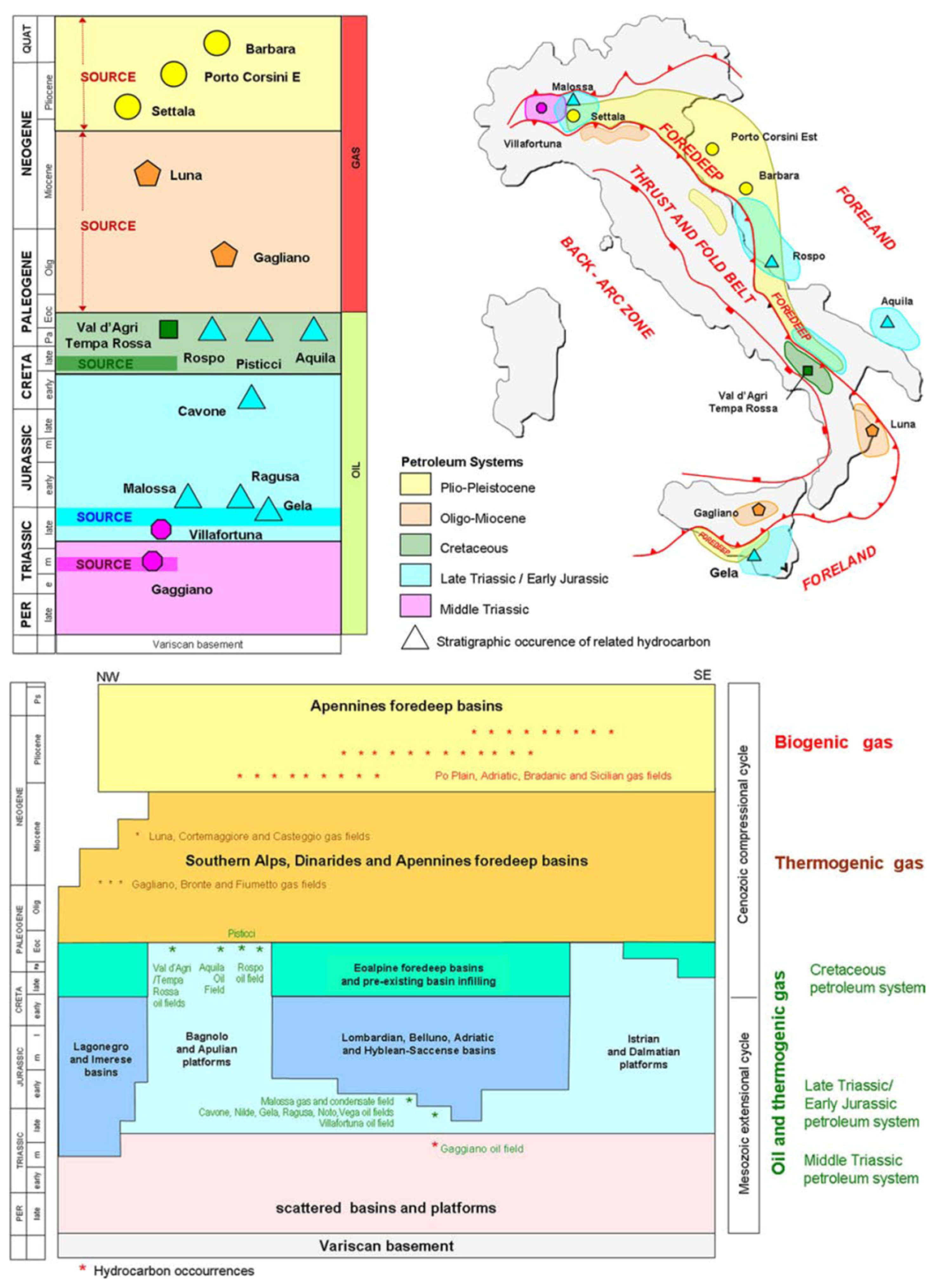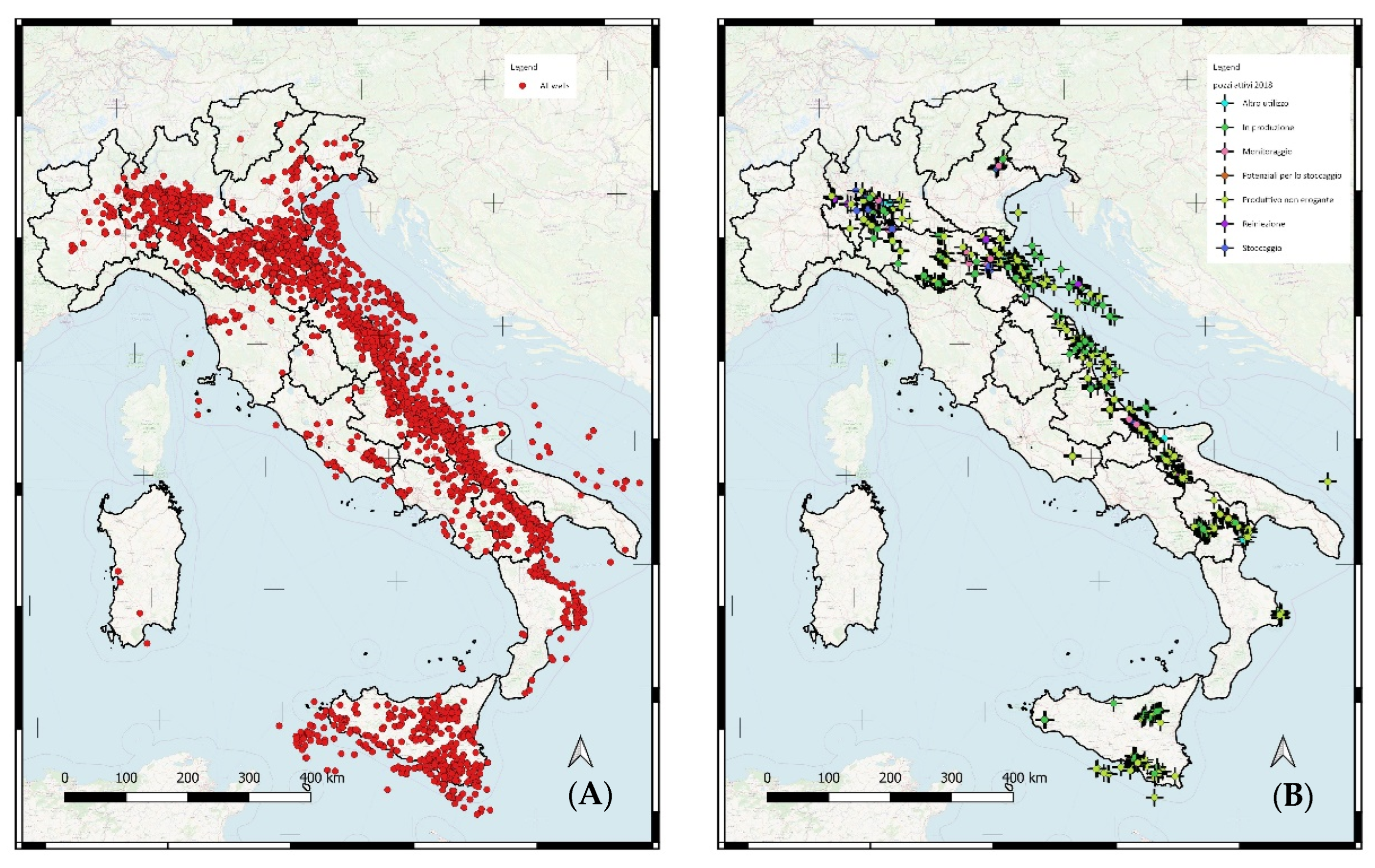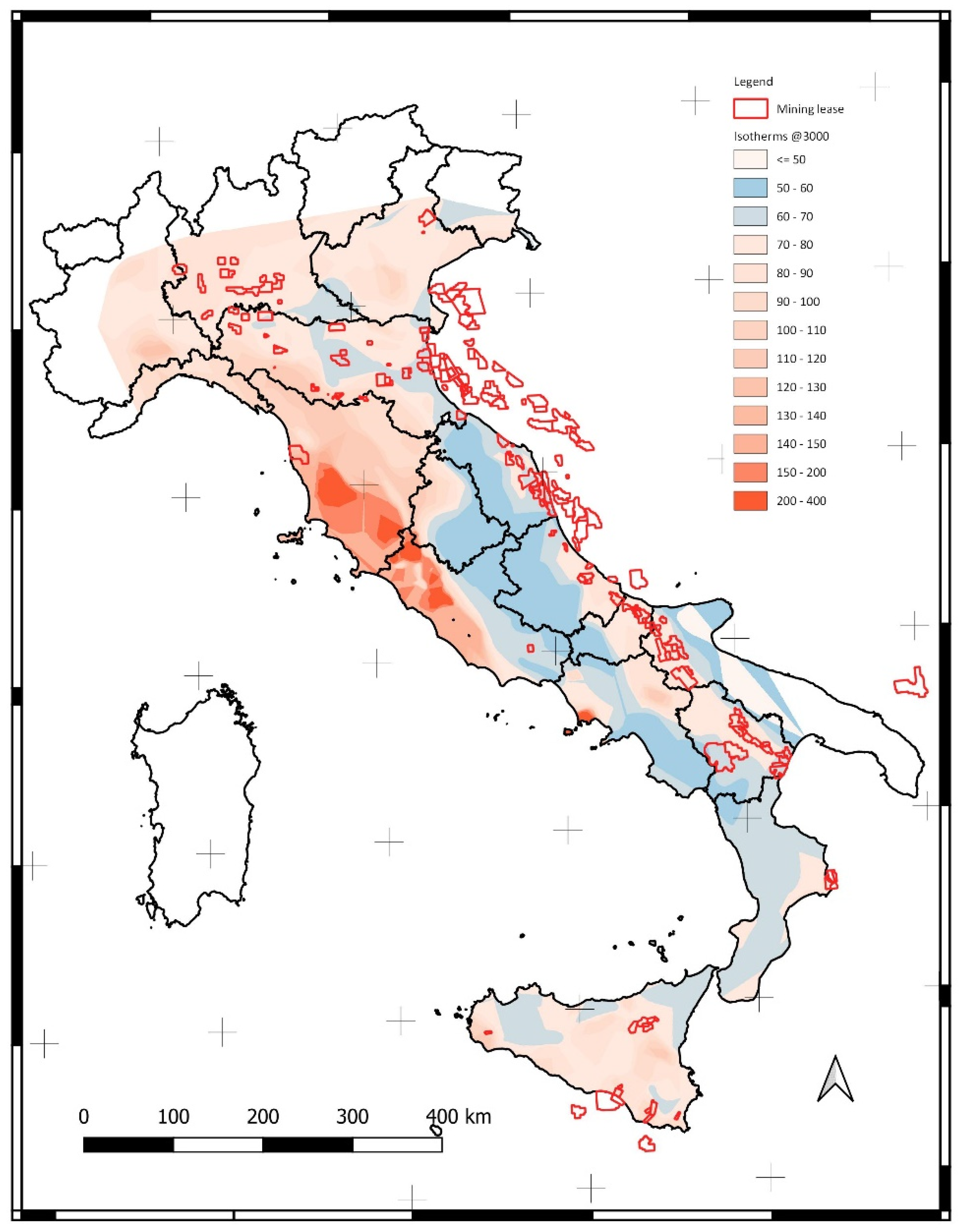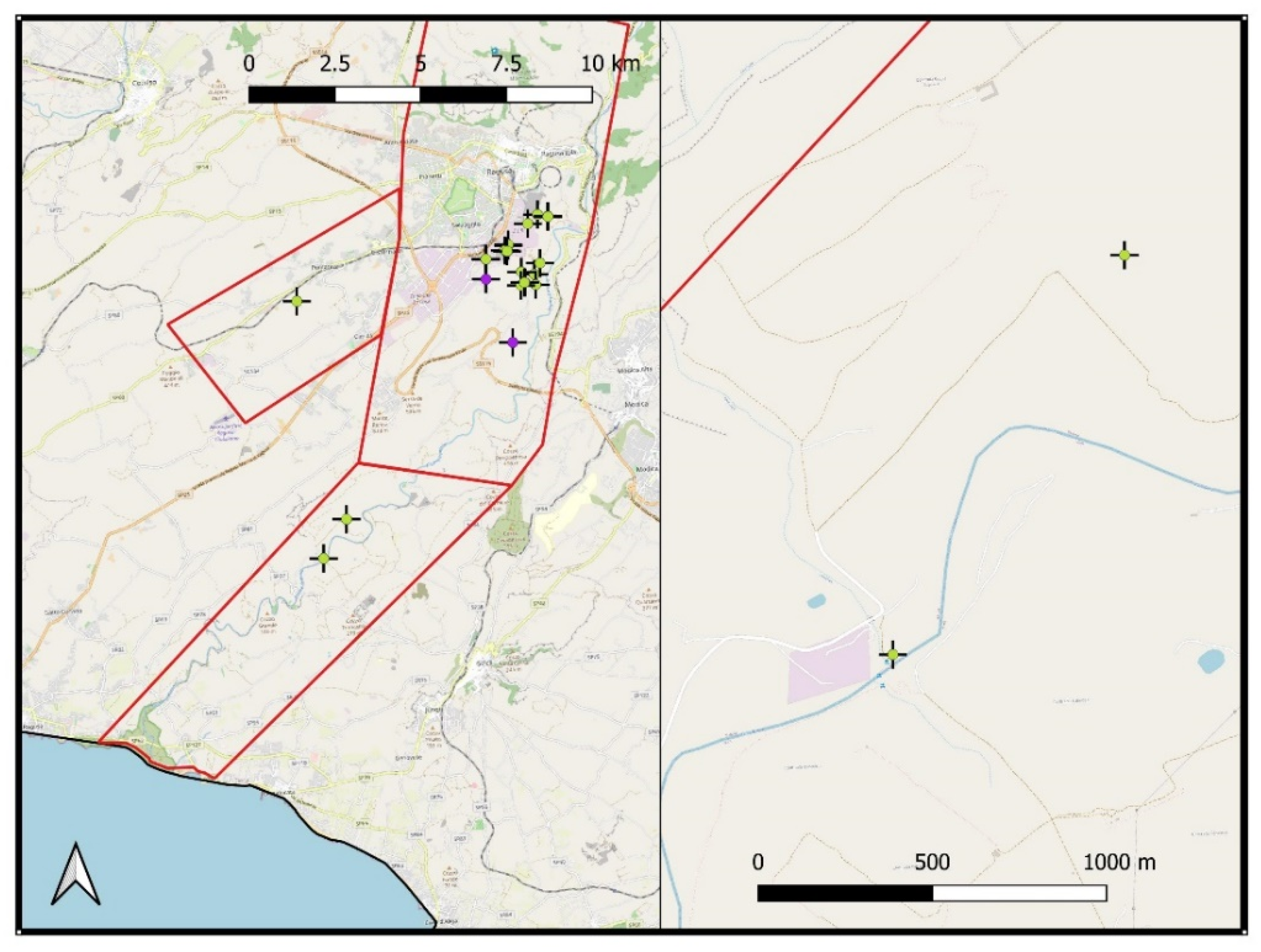Geothermal Repurposing of Depleted Oil and Gas Wells in Italy †
Abstract
:1. Introduction
2. Italian Petroleum Systems
3. Materials and Methods
4. Case Studies
4.1. Villafortuna-Trecate
4.2. Gaggiano
4.3. Irminio
5. Discussion and Conclusions
- the generation of 9 MW of electrical power.
- heating supply for 18,862 people thanks to DH.
- heating supply of 10,500 m2 of enclosed ponds.
- heating supply for 6000 m2 of greenhouses.
- the disposal of 47,160 tons of organic waste to produce 4037.7 m3/day of biogas.
- the cultivation of algae for the production of 150,000 L/year biodiesel in 1800 m2 of indoor ponds.
Conflicts of Interest
References
- McKenna, J.; Blackwell, D.; Moyes, C.; Patterson, P.D. Geothermal electric power supply possible from Gulf Coast, Midcontinent Oil Field Waters. Oil Gas J. 2005, 103, 34–40. [Google Scholar]
- Bennett, K.; Li, K.; Horne, R. Power generation potential from coproduced fluids in the Los Angeles Basin. In Proceedings of the Thirty-Seventh Workshop on Geothermal Reservoir Engineering, Stanford University, Stanford, CA, USA, 30 January–1 February 2012. [Google Scholar]
- Wang, S.; Yan, J.; Li, F.; Hu, J.; Li, K. Exploitation and Utilization of Oilfield Geothermal Resources in China. Energies 2016, 9, 798. [Google Scholar] [CrossRef]
- Wang, K.; Yuan, B.; Jia, G.; Wu, X. A comprehensive review of geothermal energy extraction and utilization in oilfields. J. Petroleum Sci. Eng. 2018, 168, 465–477. [Google Scholar] [CrossRef]
- Riney, T.D. Pleasant Bayou Geopressurised Geothermal Reservoir Analysis. J. Energy Resour. Technol. 1992, 114, 315–322. [Google Scholar] [CrossRef]
- Barbacki, A.P. The use of abandoned oil and gas wells in Poland for recovering geothermal heat. In Proceedings of the World Geothermal Congress, Kyushu-Tohoku, Japan, 28 May–10 June 2000; pp. 1–5. [Google Scholar]
- Zhang, L.; Yuan, J.; Liang, H.; Li, K. Energy from Abandoned Oil and Gas Reservoirs. In Proceedings of the Asia Pacific Oil and Gas Conference and Exhibition, Perth, Australia, 20–22 October 2008. [Google Scholar]
- Johnson, L.; Walker, E. Ormat: Low-Temperature Geothermal Power Generation; The United States Department of Energy: Wyoming, WI, USA, 2010. [Google Scholar]
- Nordquist, J.; Johnson, L. Production of Power from the Co-Produced Water of Oil Wells, 3.5 Years of Operation. In Proceedings of the Geothermal Resources Council Transactions, Geothermal Resources Council, Reno, NY, USA, 30 September–3 October 2012; Volume 36. [Google Scholar]
- Limpasurat, A.; Falcone, G.; Teodoriu, C.; Barrufet, A. Unconventional heavy oil exploitation for waste energy recovery. In Proceedings of the SPE Latin American and Caribbean Petroleum Engineer Conference, Lima, Peru, 1–3 December 2010. [Google Scholar]
- Sanyal, S.; Bulter, S. Geothermal power capacity for petroleum wells—Some case histories of assessment. In Proceedings of the World Geothermal Congress, Bali, Indonesia, 25–29 April 2010. [Google Scholar]
- Li, T.; Zhu, J.; Zhang, W. Cascade utilization of low temperature geothermal water in oilfield combined power generation, gathering heat tracing and oil recovery. Appl. Thermal Eng. 2012, 40, 27–35. [Google Scholar] [CrossRef]
- Xin, S.; Liang, H.; Hu, B.; Li, K. Electrical power generation from low temperature co-produced geothermal resources at Huabei Oilfield. In Proceedings of the 37th Workshop on Geothermal Reservoir Engineering, Stanford, CA, USA, 30 January–1 February 2012. [Google Scholar]
- Alimonti, C.; Gnoni, A. Harnessing the fluids heat to improve mature oil field: The Villafortuna–Trecate case study. J. Petroleum Sci. Eng. 2015, 125, 256–262. [Google Scholar] [CrossRef]
- Hu, K.; Zhu, J.; Zhang, W.; Li, X. A case study of an ORC geothermal power demonstration system under partial load conditions in Huabei Oilfield, China. Energy Procedia 2017, 142, 1327–1332. [Google Scholar] [CrossRef]
- Yang, Y.; Huo, Y.; Xia, W.; Wang, X.; Zhao, P.; Dai, Y. Construction and preliminary test of a geothermal ORC system using geothermal resource from abandoned oil wells in the Huabei oilfield of China. Energy 2017, 140, 633–645. [Google Scholar] [CrossRef]
- Gosnold, W. Electric Power Generation from Low to Intermediate Temperature Resources Executive; Technical Report; Univ. of North Dakota: Grand Forks, ND, USA, 2017. [Google Scholar]
- Watson, S.M.; Falcone, G.; Westaway, R. Repurposing Hydrocarbon Wells for Geothermal Use in the UK: The Onshore Fields with the Greatest Potential. Energies 2020, 13, 3541. [Google Scholar] [CrossRef]
- Auld, A.; Hogg, S.; Berson, A.; Gluyas, J. Power production via North Sea Hot Brines. Energy 2014, 78, 674–684. [Google Scholar] [CrossRef]
- Westaway, R. Repurposing of disused shale gas wells for subsurface heat storage: Preliminary analysis concerning UK issues. Q. J. Eng. Geol. Hydrogeol. 2016, 49, 213–227. [Google Scholar] [CrossRef]
- Liu, X.; Falcone, G.; Alimonti, C.A. systematic study of harnessing low-temperature geothermal energy from oil and gas reservoirs. Energy 2018, 142, 346–355. [Google Scholar] [CrossRef]
- Hirst, C.M.; Gluyas, J.G.; Mathias, S.A. The late field life of the East Midlands Petroleum Province: A new geothermal prospect? Q. J. Eng. Geol. Hydrogeol. 2015, 48, 104–114. [Google Scholar] [CrossRef]
- van der Molen, J.; Peters, E.; Jedari-Eyvazi, F.; van Gessel, S.F. Dual hydrocarbon–geothermal energy exploitation: Potential synergy between the production of natural gas and warm water from the subsurface. Neth. J. Geosci. 2020, 98, e12. [Google Scholar] [CrossRef]
- Falcone, G.; Liu, X.; Okech, R.R.; Seyidov, F.; Teodoriu, C. Assessment of deep geothermal energy exploitation methods: The need for novel single-well solutions. Energy 2018, 160, 54–63. [Google Scholar] [CrossRef]
- Westaway, R. Deep Geothermal SingleWell heat production: Critical appraisal under UK conditions. Q. J. Eng. Geol. Hydrogeol. 2018, 51, 424–449. [Google Scholar] [CrossRef]
- Trumpy, E.; Manzella, A. Geothopica and the interactive analysis and visualization of the updated Italian National Geothermal Database. Int. J. Appl. Earth Obs. Geoinf. 2017, 54, 28–37. [Google Scholar] [CrossRef]
- Pieri, M.; Mattavelli, L. Geologic framework of Italian petroleum resources. AAPG Bull. 1986, 70, 103–130. [Google Scholar]
- Mattavelli, L.; Novelli, L. Geochemistry and habitat of oils in Italy. Am. Assoc. Petroleum Geol. Bull. 1990, 74, 1623–1639. [Google Scholar]
- Mattavelli, L.; Novelli, L.; Anelli, L. Occurrence of hydrocarbons in the Adriatic Basin. Eur. Assoc. Petroleum Geosci. 1991, 1, 369–380. [Google Scholar]
- Mattavelli, L.; Pieri, M.; Groppi, G. Petroleum exploration in Italy—A review. Marine Petroleum Geol. 1993, 10, 410–425. [Google Scholar] [CrossRef]
- Anelli, L.; Mattavelli, L.; Pieri, M. Structural-stratigraphic evolution of Italy and its petroleum systems. Mèm. Mus. Natl. Hist. Nat. 1996, 170, 455–483. [Google Scholar]
- Pieri, M. Italian petroleum geology. In Anatomy of an Orogen: The Apennines and Adjacent Mediterranean Basins; Vai, G.B., Martini, I.P., Eds.; Springer: Amsterdam, The Netherlands, 2001; pp. 533–550. [Google Scholar]
- Casero, P. Structural setting of petroleum exploration plays in Italy. In Geology of Italy: Special Volume of the Italian Geological Society for the IGC 32 Florence-2004; Società Geologica Italiana: Rome, Italy, 2004; pp. 189–199. [Google Scholar]
- Bertello, F.; Fantoni, R.; Franciosi, R.; Gatti, V.; Ghielmi, M.; Pugliese, A. From thrust-and-fold belt to foreland: Hydrocarbon occurrences in Italy. In Petroleum Geology: From Mature Basins to New Frontiers, Proceedings of the 7th Petroleum Geology Conference; Geological Society of London: London, UK, 2010; pp. 113–126. [Google Scholar] [CrossRef]
- Cazzini, F.; Zotto, O.D.; Fantoni, R.; Ghielmi, M.; Ronchi, P.; Scotti, P. Oil and gas in the Adriatic foreland, Italy. J. Petroleum Geol. 2015, 38, 255–279. [Google Scholar] [CrossRef]
- Zappaterra, E. Source-rock distribution model of the Periadriatic Region. AAPG Bull. 1994, 78, 333–354. [Google Scholar]
- Ziegler, P.A.; Roure, F. Petroleum systems of Alpine-Mediterranean fold belts and basins. In The Mediterranean Basins: Tertiary Extension within the Alpine Orogen; Durand, B., Jolivet, L., Horvnth, E., Sèranne, M., Eds.; Geological Society: London, UK, 1999; pp. 517–540. [Google Scholar]
- Jenkyns, H.C. Geochemistry of oceanic anoxic events. Geochem. Geophys. Geosyst. 2010, 11, Q03004. [Google Scholar] [CrossRef]
- Magoon, L.B.; Dow, W.G. The petroleum system. In The Petroleum System—From Source to Trap; AAPG: Tulsa, OK, USA, 1994; pp. 3–24. [Google Scholar]
- UNMIG-MISE. National Mining Office for Hydrocarbon and Georesources of the Ministry for Economic Development. 2019. Available online: https://unmig.mise.gov.it/index.php/it/dati/ricerca-e-coltivazione-di-idrocarburi (accessed on 26 February 2020).
- ViDEPI Project. Visibility of Petroleum Exploration Data in Italy. Ministry for Economic Development DGRME—Italian Geological Society—Assomineraria. 2019. Available online: http://www.videpi.com/videpi/videpi.asp (accessed on 26 February 2020).
- Schlumberger. Well Evaluation Conference; WEC: Milan, Italy, 1987. [Google Scholar]
- Sella, M.; Turci, C.; Riva, A. Sintesi geopetrolifera della Fossa Bradanica (avanfossa della catena appenninica meridionale). Mem. Soc. Geol. Ital. 1988, 41, 87–107. [Google Scholar]
- HIS Energy Group. Italy, E&P current licensing status. Map scale 1:1.250.000. In Proceedings of the 64th EAGE Conference, Florence, Italy, 27–30 May 2002. [Google Scholar]
- Cataldi, R.; Mongelli, F.; Squarci, P.; Taffi, L.; Zito, G.; Calore, C. Geothermal ranking of Italian territory. Geothermics 1995, 1, 115–129. [Google Scholar] [CrossRef]






| Petroleum System | Reservoir Source Rock | Representative Fields |
|---|---|---|
| Middle Triassic | Fractured and dolomitized shelf carbonates, hosted in trust-related folds and sealed by marly and volcanoclastic units, are charged by the Besano Shales (Anisian/Ladinian) and Meride Limestone (Ladinian) source rocks. | Villafortuna–Trecate oil field, discovered in 1984 with a cumulative production at the end of 2000 of 188 Mbo of 43° API oil and more than 2000 MSTm3 of gas. |
| Late Triassic–Early Jurassic | Oil accumulations in a variety of stratigraphic intervals of the Mesozoic-Early Cenozoic sedimentary cover overlying Late Triassic–Early Jurassic source rocks in traps generally represented by reactivated structures occurring along the foreland margin. | Gela oil field in Sicily discovered in 1956 with reserves of 130–150 Mbo. |
| Cretaceous | The reservoir is made up by Cretaceous-Middle Miocene fractured shallow-water limestone and dolostones sealed by shaly units in traps represented by thrust-related folds. It is charged by an Albian–Cenomanian organic-rich carbonate source rock deposited in isolated basins developed during the Cretaceous anoxic events within the long-lasting Apulian carbonate platform. | Val d’Agri oil field, discovered in 1988 with estimated reserves of about 480 Mbo of 26°–42° API oil. |
| Thermogenic gas in Oligo-Miocene foredeep | This system is associated with an early thermogenic generation from the gas-prone organic matter contained in the shaly levels that charged the turbidite reservoirs. Hydrocarbon accumulations hosted in structural traps with some light oil and condensate. | Typical examples are the Gagliano and Luna gas fields. |
| Biogenic gas in Plio-Pleistocene foredeep | The sand-rich turbidite reservoir is charged with biogenic gas by the interbedded clay levels, characterised by an organic matter of terrestrial origin, which also provides the seal. Traps are usually structural although several stratigraphic traps have been also recognised. | Porto Corsini East and Barbara gas fields. |
| Power Plant | DH Plant | Aquaculture Plant | |
|---|---|---|---|
| Inhabitants/Pond area | 15,700 | 4500 m2 | |
| Power (MW) | 6 | 22.5 | - |
| Energy produced (MWh) | 45,000 | - | |
| Supplied consumers | 32,143 | 11,268 | - |
| Plant cost (M€) | 12 | 40.5 | 0.697 |
| Revenues per year (M€) | 1.7 | 5.25 | 0.14 |
| Payback time (year) | 4.5 | 7.7 | 4.9 |
| Power Plant | DH Plant | Aquaculture Plant | |
|---|---|---|---|
| Inhabitants/Pond area | 5635 | 2800 m2 | |
| Power (MW) | 3 | 11.2 | - |
| Energy produced (MWh) | 22,500 | - | |
| Supplied consumers | 16,071 | 5635 | - |
| Plant cost (M€) | 6.6 | 21 | 0.456 |
| Revenues per year (M€) | 1.35 | 2.7 | 0.088 |
| Payback time (year) | 5 | 7.75 | 5.2 |
| DH Plant | Greenhouse Plant | Aquaculture Plant | |
|---|---|---|---|
| Inhabitants/Pond area | 4584 | 6000 m2 | 3200 m2 |
| Power (MW) | 3.92 | - | - |
| Supplied consumers | 1960 | - | - |
| Plant cost (M€) | 7 | 0.33 | 0.515 |
| Revenues per year (M€) | 0.95 | 0.09 | 0.10 |
| Payback time (year) | 7.4 | 3.7 | 5.1 |
| Installation cost | 2.05 M€ |
| Installed electrical power | 360 kW |
| Installed thermal power | 568 kW |
| Revenue from electricity | 151.200 €/y |
| Gas produced | 1,108,761 m3 |
| Revenue from gas | 243,927 € |
| Annual revenue | 395,127 € |
| Payback time | 5.2 years |
| Area of the indoor pond | 1800 m2 |
| Installation plant cost | 306,000 € |
| Biodiesel produced | 155,000 L/y |
| Annual revenue from biodiesel | 70,060 € |
| Payback time | 4.3 years |
Publisher’s Note: MDPI stays neutral with regard to jurisdictional claims in published maps and institutional affiliations. |
© 2020 by the authors. Licensee MDPI, Basel, Switzerland. This article is an open access article distributed under the terms and conditions of the Creative Commons Attribution (CC BY) license (https://creativecommons.org/licenses/by/4.0/).
Share and Cite
Soldo, E.; Alimonti, C.; Scrocca, D. Geothermal Repurposing of Depleted Oil and Gas Wells in Italy. Proceedings 2020, 58, 9. https://doi.org/10.3390/WEF-06907
Soldo E, Alimonti C, Scrocca D. Geothermal Repurposing of Depleted Oil and Gas Wells in Italy. Proceedings. 2020; 58(1):9. https://doi.org/10.3390/WEF-06907
Chicago/Turabian StyleSoldo, Elena, Claudio Alimonti, and Davide Scrocca. 2020. "Geothermal Repurposing of Depleted Oil and Gas Wells in Italy" Proceedings 58, no. 1: 9. https://doi.org/10.3390/WEF-06907
APA StyleSoldo, E., Alimonti, C., & Scrocca, D. (2020). Geothermal Repurposing of Depleted Oil and Gas Wells in Italy. Proceedings, 58(1), 9. https://doi.org/10.3390/WEF-06907





